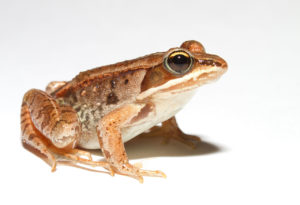06
Mar
Study Shows Impact of Neonicotinoids in Amphibians
(Beyond Pesticides, March 6, 2017) A study published last month by Canadian researchers finds that exposure to the neonicotinoid insecticide imidacloprid at environmentally relevant levels results in slight delays in metamorphosis in the tadpoles of the wood frog. While the authors find that this slight delay is not necessarily a cause for concern from an ecological perspective, sublethal effects of pesticide mixtures and a variety of stressors in the environment play a role in extending juvenile periods in frogs, which can increase mortality and population decline. Because neonicotinoids are so widely use, the authors recommend further research on their impact on declining frog populations.
 The study, published in Environmental Toxicology and entitled, “Sublethal effects on wood frogs chronically exposed to environmentally relevant concentrations of two neonicotinoid insecticides,” looks at the chronic exposure effects of the neonicotinoids imidacloprid and thiamethoxam on the wood frog (Lithobates sylvaticus). The wood frog was chosen because it is native to North America and has a wide distribution across the continent. The researchers exposed tadpoles to environmentally relevant concentrations (1ug/L, 10ug/L and 100ug/L) of the commercial formulation of the neonicotinoids (Admire and Actara). The study finds a significant difference in time for tadpoles to metamorphose. Tadpoles exposed to the medium and high concentrations of imidacloprid were delayed in completing metamorphosis, compared to the controls. There was no treatment related effects with thiamethoxam. Interestingly, the study reports that imidacloprid seemed to decrease tadpole mortality, which the authors theorize may be influenced by altered behavior in exposed frogs, and warrants further study.
The study, published in Environmental Toxicology and entitled, “Sublethal effects on wood frogs chronically exposed to environmentally relevant concentrations of two neonicotinoid insecticides,” looks at the chronic exposure effects of the neonicotinoids imidacloprid and thiamethoxam on the wood frog (Lithobates sylvaticus). The wood frog was chosen because it is native to North America and has a wide distribution across the continent. The researchers exposed tadpoles to environmentally relevant concentrations (1ug/L, 10ug/L and 100ug/L) of the commercial formulation of the neonicotinoids (Admire and Actara). The study finds a significant difference in time for tadpoles to metamorphose. Tadpoles exposed to the medium and high concentrations of imidacloprid were delayed in completing metamorphosis, compared to the controls. There was no treatment related effects with thiamethoxam. Interestingly, the study reports that imidacloprid seemed to decrease tadpole mortality, which the authors theorize may be influenced by altered behavior in exposed frogs, and warrants further study.
“The slight delay in development may not be cause for concern on its own; however, in the natural environment, additional stressors, such as mixtures of pesticides, predators, or parasites, can contribute to further delays,” said Stacey Robinson, PhD, lead author of the study. “Such cumulative stressors are important to consider in understanding the potential impact on amphibian populations.”
Neonicotinoids are one of the most widely used pesticides in the world. They are systemic pesticides that have the ability move through the plants vascular system and are expressed through pollen, nectar, and guttation droplets. These pesticides, which include imidacloprid, thiamethoxam, dinotefuran, acetamiprid, and clothianidin have been found by a growing body of scientific literature to be linked to pollinator decline in general. However, studies are also reporting that these pesticides also impact aquatic communities. Neonicotinoids are pervasive in U.S. waterways, according to the U.S. Geological Survey (USGS) and have been shown to be toxic to aquatic invertebrates. Aquatic invertebrates play an important role in ecological diversity, and neonicotinoids can exert adverse effects on survival, growth, emergence, mobility, and behavior of many sensitive aquatic invertebrate taxa. One Dutch study, Van Dijk et al. (2013), reports decreased species abundance in aquatic macrofauna, and others show that aquatic insects are impacted at levels ranging from 3-13 ppb. These impacts can devastate aquatic communities and higher trophic organisms which depend on these organisms, like birds.
In early January of this year, the U.S. Environmental Protection Agency (EPA), in regulating the sale and use of pesticides in the U.S., released the ecological (aquatic) assessment for imidacloprid, which found elevated risks to aquatic organisms. This follows earlier publication of imidacloprid’s pollinator assessment and release of the pollinator assessments of three other neonicotinoids (clothianidin, thiamethoxam, dinotefuran). See Daily News Blog. However, imidacloprid’s aquatic assessment and the assessments of the three other neonicotinoids have not been published in the Federal Register to solicit public comments. Public comments are necessary to ensure transparency and independent vetting of EPA’s science and risk assessment conclusions.
In light of the shortcomings of federal action in the U.S. to protect these beneficial organisms, it is left up to us to act. You can pledge to stop using neonicotinoids and other toxic pesticides. Sign the pollinator protection pledge today. Beyond Pesticides also advocates the adoption of organic land management practices and policies by local communities that eliminate the use of toxic pesticides in our environment.
Source: Phys.org
All unattributed positions and opinions in this piece are those of Beyond Pesticides.










